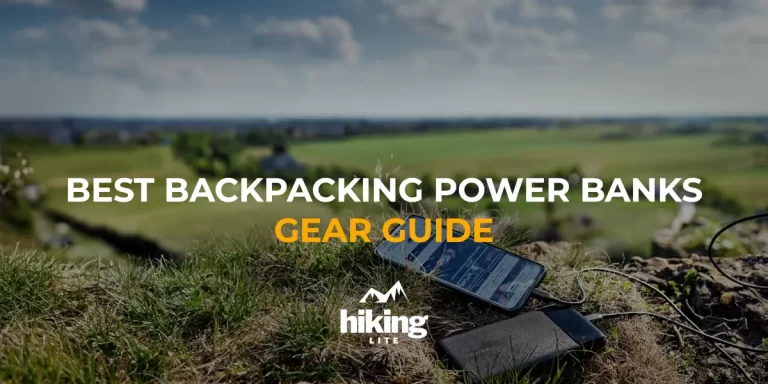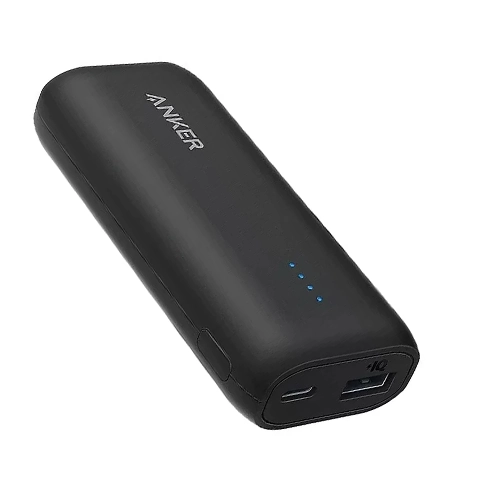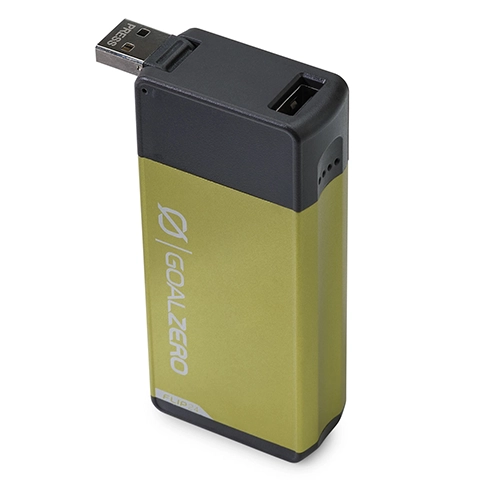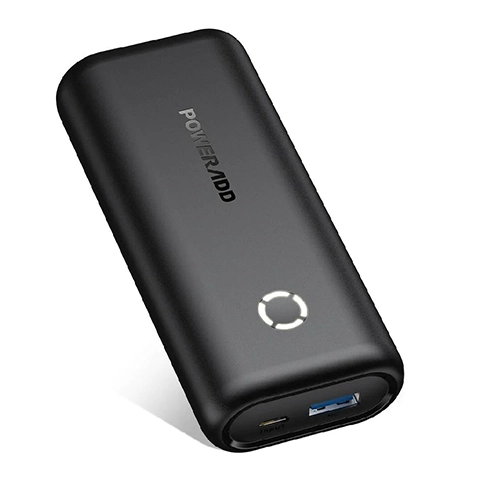

Staying powered up while backpacking can be challenging. Battery banks designed for heavy use tend to be bulky and weigh a ton, making them impractical for lightweight trips.
However, there are some excellent lightweight and ultralight options that can keep your devices charged without breaking your back.
In this guide, we’ll cover the best backpacking power banks based on capacity and weight. Whether you’re hitting the trail for a weekend getaway or thru-hiking the PCT, we’ve got you covered.

Key Specs
Weight: 4.16 ounces (118 grams)
Capacity: 5000 mAh
Price: $
PROS
✅ Ultralight
✅ High-Speed Charging (12W)
CONS
❌ Modest capacity
The Anker 321 Power Bank is a great portable charging option for outdoor adventures. At just 4.16 ounces, it’s incredibly light to pack along without adding much bulk. Despite its small size, it packs a decent capacity of 5,200 mAh which is enough to fully charge most phones once or twice.
It has both USB-A and USB-C ports so you can charge a variety of devices simultaneously. I tested it charging my iPhone and AirPods without issue. Anker also includes various safety protections like temperature control and short circuit prevention to keep your devices safe during charging.
During a typical 2-3 day hiking trip, I found the 321 provided enough additional battery to keep my phone and accessories charged the entire time. I packed it along on several day hikes and was never lacking power when I needed to navigate or take photos. It easily added an extra full charge to my iPhone each evening.
If you’re planning longer trips spanning a week or more, you may want a higher capacity battery bank. But for most shorter outdoor excursions, the Anker 321 is a reliable and lightweight companion for keeping your gear juiced up.

Key Specs
Weight: 5.29 ounces (150 grams)
Capacity: 10 000 mAh
Price: $
PROS
✅ Durable
✅ Favorite among ultralight hikers
CONS
❌ Materials could be better
The Nitecore NB10000 Gen 2 Power Bank is a fantastic portable charging option for ultralight backpackers. At just 5.29 ounces, it manages to pack a substantial 10,000 mAh capacity into its lightweight carbon fiber body. That high capacity means it can fully recharge most phones 2-3 times on a single charge.
I appreciated its ability to simultaneously charge two devices using both its USB-A and USB-C ports. This is ideal for multi-day trips where multiple pieces of gear need charging. Safety protections like over-current and temperature control give peace of mind.
Where this power bank really excels is its compact size and featherweight construction. Despite packing 10,000 mAh of juice, it slipped effortlessly into any pocket or hip belt pocket on my backpack. The carbon fiber shell kept it super slim so it never added meaningful bulk.
My one minor quibble is that the edges are quite sharp, so stuffing it loosely in a pack risks snagging on fabric over time. I’d recommend using a small stuff sack or wrapping it in clothing to protect your pack. However, this is a small tradeoff for its awesome capacity-to-weight ratio.
For ultralight adventures where ounce counts, the Nitecore NB10000 Gen 2 is unbeatable in providing long-lasting portable power without the weight penalty.

Key Specs
Weight: 7.48 ounces (212 grams)
Capacity: 10 000 mAh
Price: $
PROS
✅ Reasonably powerful
✅ Durable
CONS
❌ Not the fastest to charge
The Anker 313 packs a substantial 10,000mAh capacity into a slim package; it provides multiple charges for phones, headphones, and more. Its lightweight construction makes it easy to toss into any pocket for extended periods in the field.
Where this charger really shines is its dependability. Anker’s solid build quality means it has handled bumps and falls without issue over many months of regular use. I can trust that it will be ready to power up my devices in any situation.
That said, there is room for improvement in charging speeds. At just 5V/2A output, it can take a while to fully charge larger devices like phones compared to faster chargers. And recharging the power bank itself is no quick affair. Some may find these slower speeds hamper its real-world utility.
Overall though, for my needs of extra battery capacity while backpacking, the 313 continues to be worth its weight. Its long-lasting 10,000mAh output and tough design compensate for any speed critiques. And Anker’s reputation for quality assures it will deliver dependable power for many trips to come.

Key Specs
Weight: 4.6 ounces (130 grams)
Capacity: 6700 mAh
Price: $$
PROS
✅ Flip out USB output for recharging
✅ Metal body
CONS
❌ Charging hinge durability
The Goal Zero Flip 24 delivers reliable charging capacity in a compact package. Its 6,700mAh battery can fully recharge most phones two to three times over, or provide a sizable boost to larger devices like tablets.
Built from sturdy aluminum, the Flip 24 feels tough enough to withstand occasional bumps and drops. Its solid construction makes me confident it can take hit after hit in the field. That said, some reports indicate it may struggle in extremely frigid conditions due to its metallic body. I didn’t test this myself but it’s worth noting for alpine adventures.
My only minor quibble after long-term use is potential durability concerns with the hinge mechanism over many charge cycles. The cable stows neatly but repetitive opening and closing risks weakening the port connection long term. So far it continues operating flawlessly with careful handling.
Overall, for its compact size the Flip 24 continues delivering dependable power pack after pack. Its aluminum shell feels built to last through harsh outdoor use. While not the longest lasting or highest capacity, for extended trips its lightweight ruggedness makes it a well-rounded go-to battery buddy.

Key Specs
Weight: 5.99 ounces (170 grams)
Capacity: 10 000 mAh
Price: $
PROS
✅ Extremely affordable
✅ Charges fast
CONS
❌ Capacity is a bit lower than claimed
The Poweradd 10,000mAh portable charger is an affordable option that delivers convenient charging capabilities for most lightweight adventures. It offers a decent charging speed to top off devices quickly between activities.
However, it’s important to note that real-world capacity may be closer to 7,200 mAh rather than the advertised 10,000 mAh rating. While still providing multiple charges for phones and GPS units, expectations should be adjusted according.
A minority of users also reported some early quality issues, like buttons ceasing to work after only a few weeks. Thankfully, Poweradd customer support has been responsive in replacing defective units for most complaints found online. Proper handling is still advised to maximize durability.
Considering its fair price point, the Poweradd portable charger satisfies average charging needs of lightweight trips when packed with care. Just be aware its performance specs may fall slightly below the rated thresholds. But for budget-conscious backpackers, it delivers good value if utilized properly and supported well by the manufacturer’s warranty.
When selecting a portable charger for backpacking, there are several key factors to consider. Carefully evaluating capacity, power output, and compatibility will ensure you get a power bank suited to your trip needs.
Capacity
Capacity refers to how much charge the power bank can store, measured in milliamp-hours (mAh) or watt-hours (Wh). Estimate your devices’ typical daily power usage to determine adequate capacity. Keep in mind charging efficiency is less than 100%, so add extra capacity for safety. Larger capacities of 10,000mAh or more allow for multiday trips with limited access to outlets.
Power Output
Check the power bank’s voltage and current output to ensure safe, effective charging of your devices. USB-A and USB-C are most common. Quick charge or higher amperage outputs like 2.1A or 3A can speed up charging but require compatible devices. Stick with reputable brands to avoid safety issues.
Compatibility
Ensure the power bank works with your devices’ charging ports to avoid compatibility headaches on trail. Multi-port options provide versatility. Consider weight and portable design features when backpacking long distances.
Trip Duration
Short trips may require just 5,000mAh while extended trips warrant 10,000mAh or greater. Balance capacity with weight. Test options on practice trips to assess individual power needs over different conditions. With careful device management, a capable power bank enables unplugged adventure.
For additional insights and tips on power banks, check out our detailed post here.
When selecting a rechargeable power bank for travel, camping, and extended trips away from outlets, aim for a capacity of 10,000mAh or higher to ensure your smartphone and other electronics have sufficient power for multiday excursions. A larger capacity rechargeable power bank that is around 10,000mAh will provide multiple full charges for mobile devices like smartphones as well as partial charges for other electronics like cameras, keeping you powered up for outdoor adventures whether backpacking, car camping, or just traveling light.
When choosing a power bank to bring along on hiking trips or for other on-the-go technology needs, make sure it has important safety features to protect your devices. Opt for a model with short circuit, overcharging, and overcurrent protection to prevent damage from occurring. Look for one with efficient power conversion as excessive heat can pose a risk. Well-known brands are likely to implement the proper safeguards. With safety top of mind, you can enjoy the convenience and reliability of portable power during outdoor adventures without worrying about unexpected issues arising.
When evaluating the charging speeds of various portable chargers, pay close attention to both the power bank’s output specs and your devices’input capabilities. Consider the power bank’s voltage and current output in amps – higher amperage like 3A provides faster charging than 1A. However, your device must support quicker charging standards like Quick Charge. Test charge times in advance by comparing how long it takes different power banks to fully charge your phone or other key electronics from empty. Faster charging saves time on the trail even if it reduces battery life longevity. balanced with other factors like size, weight, and capacity.
While traditional lithium-ion power banks remain the most widespread option, solar-powered variants are growing in popularity for backcountry travelers seeking sustainable charging solutions. Some portable chargers feature integrated solar panels that allow them to replenish their stored power from direct sunlight, eliminating the need to find an electrical outlet during extended trips. Though less powerful than wall outlets, solar charging keeps devices running when natural energy is readily available. Look for high-capacity solar power banks from brands like Goal Zero or Anker to keep gadgets powered via the sun’s renewable rays while deep in the wilderness.